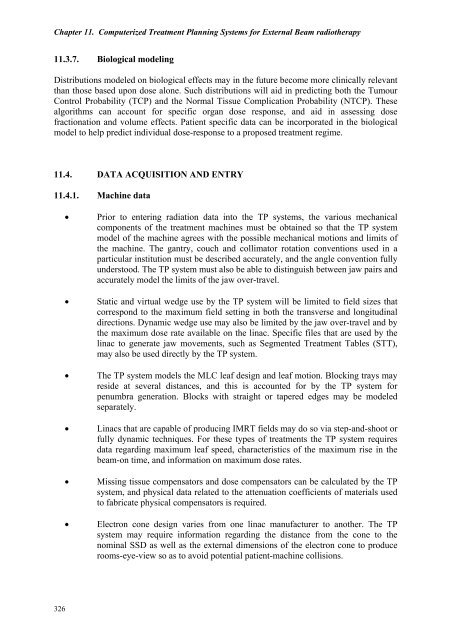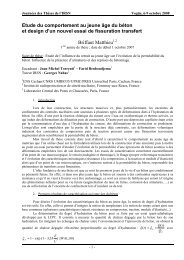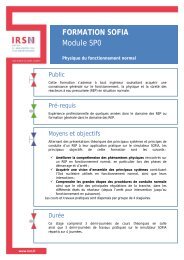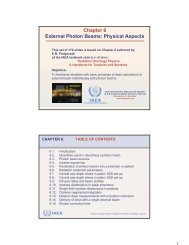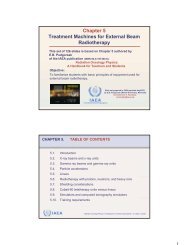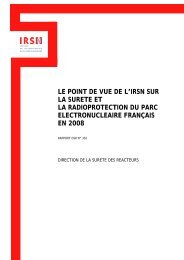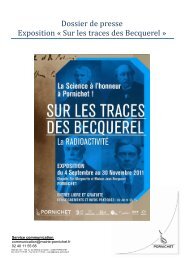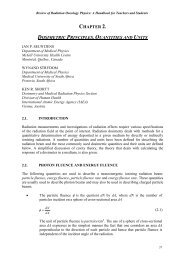Chapter 11. Computerized Treatment Planning Systems <strong>for</strong> External Beam radiotherapy11.3.7. Biological modelingDistributions modeled on biological effects may in the future become more clinically relevantthan those based upon dose alone. Such distributions will aid in predicting both the TumourControl Probability (TCP) and the Normal Tissue Complication Probability (NTCP). Thesealgorithms can account <strong>for</strong> specific organ dose response, and aid in assessing dosefractionation and volume effects. Patient specific data can be incorporated in the biologicalmodel to help predict individual dose-response to a proposed treatment regime.11.4. DATA ACQUISITION AND ENTRY11.4.1. Machine data• Prior to entering radiation data into the TP systems, the various mechanicalcomponents <strong>of</strong> the treatment machines must be obtained so that the TP systemmodel <strong>of</strong> the machine agrees with the possible mechanical motions and limits <strong>of</strong>the machine. The gantry, couch and collimator rotation conventions used in aparticular institution must be described accurately, and the angle convention fullyunderstood. The TP system must also be able to distinguish between jaw pairs andaccurately model the limits <strong>of</strong> the jaw over-travel.• Static and virtual wedge use by the TP system will be limited to field sizes thatcorrespond to the maximum field setting in both the transverse and longitudinaldirections. Dynamic wedge use may also be limited by the jaw over-travel and bythe maximum dose rate available on the linac. Specific files that are used by thelinac to generate jaw movements, such as Segmented Treatment Tables (STT),may also be used directly by the TP system.• The TP system models the MLC leaf design and leaf motion. Blocking trays mayreside at several distances, and this is accounted <strong>for</strong> by the TP system <strong>for</strong>penumbra generation. Blocks with straight or tapered edges may be modeledseparately.• Linacs that are capable <strong>of</strong> producing IMRT fields may do so via step-and-shoot orfully dynamic techniques. For these types <strong>of</strong> treatments the TP system requiresdata regarding maximum leaf speed, characteristics <strong>of</strong> the maximum rise in thebeam-on time, and in<strong>for</strong>mation on maximum dose rates.• Missing tissue compensators and dose compensators can be calculated by the TPsystem, and physical data related to the attenuation coefficients <strong>of</strong> materials usedto fabricate physical compensators is required.• Electron cone design varies from one linac manufacturer to another. The TPsystem may require in<strong>for</strong>mation regarding the distance from the cone to thenominal SSD as well as the external dimensions <strong>of</strong> the electron cone to producerooms-eye-view so as to avoid potential patient-machine collisions.326
<strong>Review</strong> <strong>of</strong> <strong>Radiation</strong> Oncology <strong>Physics</strong>: A Handbook <strong>for</strong> Teachers and Students11.4.2. Beam data acquisition and entry• The beam data required by the TP system must be well understood. This isespecially true when acquiring beam data from the treatment units. Specialconsideration must be given to the geometry <strong>of</strong> the radiation detector (typicallyionisation chambers or diodes), and any geometrical correction factors that mustbe applied to the data. Beam data is <strong>of</strong>ten smoothed and re-normalized bothfollowing measurement and prior to data entry into the TP computer.• Typical photon beam data sets include central axis PDDs and <strong>of</strong>f-axis ratios(pr<strong>of</strong>iles) <strong>for</strong> open and wedged fields <strong>for</strong> a range <strong>of</strong> square fields. Diagonal fieldpr<strong>of</strong>iles to account <strong>for</strong> radial and transverse open beam asymmetry and wedgedfield lateral pr<strong>of</strong>iles to account <strong>for</strong> the variation in wedge hardening <strong>of</strong>f axis mayalso be required. In the case <strong>of</strong> diagonal pr<strong>of</strong>iles it may only be possible toacquire half field scans depending upon the size <strong>of</strong> the water tank.• Penumbra may be fitted to, or extracted from, measured data. In either case it isimportant that scan lengths be <strong>of</strong> sufficient length, especially <strong>for</strong> pr<strong>of</strong>iles at largedepths where field divergence can become considerable.• Relative or absolute field size factors are required <strong>for</strong> TP systems. These valuesare used both in treatment time calculations and in the calculation <strong>of</strong> dosedistributions involving dynamic beams (dynamic wedge, dynamic MLC, etc).Particular care must be taken with respect to the reference field size, referencedepth and nominal SSD, as these will have a global effect on time and MonitorUnit calculations. Central axis wedge factors, tray factors and other accessoryfactors (normally the ratio <strong>of</strong> dose with and without the accessory) are alsorequired by the TP system.• Measured beam data relevant to the MLC can include transmission through theleaf, inter-leaf transmission between adjacent leaves, and intra-leaf transmissionoccurring when leaves from opposite carriage banks meet end-on.• Beam measurement <strong>for</strong> electrons is more difficult than <strong>for</strong> photons because <strong>of</strong> thecontinuously decreasing energy <strong>of</strong> the beam with depth. Electron beam datameasured with ionisation chambers must be first converted to dose with anappropriate method, typically using a look-up table <strong>of</strong> stopping power ratios.Measurements with silicon diodes are <strong>of</strong>ten considered to be tissue equivalent andgive a direct reading in dose.• Monte Carlo TP systems require accurate in<strong>for</strong>mation concerning the geometryand composition <strong>of</strong> linac beam-line components, such as the waveguide exitwindow, target, flattening filter, scattering foil, transmission ionisation chamber,jaws, MLC, blocks and trays, and any other items the electron or photon beam islikely to encounter.• Beam data acquired from a linac may be entered manually using a digitizer tabletand tracing stylus. Hardcopy <strong>of</strong> beam data is used, and it is important that boththe beam data printout and the digitizer be routinely checked <strong>for</strong> calibration.327


